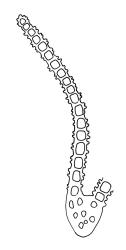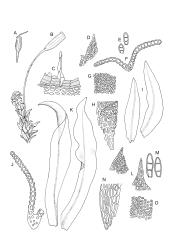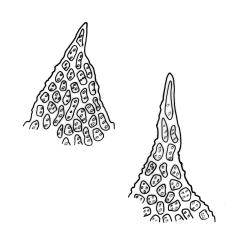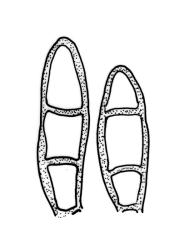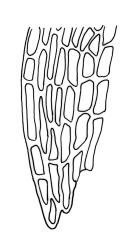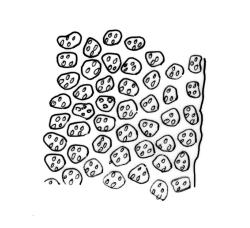- = Zygodon mucronatus Müll.Hal., Hedwigia 37: 136 (1898) nom. illeg., non Zygodon mucronatus Broth. 1897
Plants medium-sized, usually in loose tufts or mats, green to yellow-green above, red-brown to brown below, dull. Stems (8–)10–30 mm, much branched (mostly or entirely by innovation), in cross-section with small, incrassate cortical cells, thick-walled internal cells, and lacking a central strand; rhizoids well-developed and extending well up the stem, red-brown, finely papillose. Leaves loosely twisted around the stems and often contorted when dry, loosely spreading or somewhat recurved and ± undulate when moist, lanceolate or linear-lanceolate, narrowly acute, entire or with a few teeth near apex, slightly decurrent, weakly keeled, ± undulate, plane at margins, (0.9–)1.4–2.4 × 0.3–0.45 mm (under cover slip); upper laminal cells irregularly rounded, almost isodiametric or some ± oval, thick-walled, mostly 7–12(–14) µm in greater diam., mostly with 4–7 short, simple, and round papillae on each surface; basal cells rounded-rectangular or rectangular, moderately thick-walled, smooth, c. 12.5–45 × 4.5–10 µm. Costa ending shortly below the apex or rarely percurrent and slightly widened in the apex, with cells on both surfaces elongate, protruding on the abaxial leaf surface and lustrous when dry. Gemmae rarely seen, axillary, clavate, green, usually with 2 transverse, hyaline septa, c. 65–90 μm.
Synoicous. Perichaetia terminal, usually overtopped by 1 or more innovations, with archegonia, antheridia and paraphyses; perichaetial leaves smaller than adjacent vegetative leaves, ovate-lanceolate and long acuminate. Perigonia lacking. Setae (6–)10–15(–20) mm, dextrorse above, pale yellow-brown; capsules exserted, oblong-cylindric when moist, oblong with a long slender neck when dry and becoming cylindric and deeply 8-furrowed with age, orange-brown to light brown, 1.5–2.2 mm; exothecial cells with longitudinal walls much thicker than transverse, arranged in alternating bands of thick- and thin-walled cells; stomata restricted to neck, superficial; annulus not seen; operculum obliquely long-rostrate from a conic base, c. ½ the length of the capsule. Peristome single; endostome of 8 (rarely 16), hyaline, smooth, filiform segments. Calyptra cucullate. Spores globose, papillose, brown, (14–)20–25(–28) µm.
Malta 1926, fig. 72; Lewinsky 1990, figs 156–175, 176–177; Calabrese 2006, 2b, 21 (as Z. hookeri var. hookeri).
While similar in many ways to the more widespread and closely related Z. intermedius, Z. hookeri is generally a more robust plant in which the vegetative leaves are both longer and wider, the perichaetial leaves more strongly differentiated, the setae and the capsules longer, and the spores larger. According to Lewinsky (1990), Z. hookeri has a more open growth and more twisted, undulate leaves. The synoicous inflorescence of the present species distinguishes it from Z. intermedius under the stereoscope.
NI: S Auckland (near Ātiamuri, near Rangitikei), Hawke’s Bay (Back Ridge), Wellington (Ōhakune, Mangawhero Falls); SI: Nelson, Marlborough (south flank of Red Hills), Canterbury, Westland (Taramakau), Otago, Southland. The N.Z. distribution was mapped by Lewinsky (1990, fig. 181). The majority of Canterbury L.D. records are from the Arthur’s Pass area, extending eastward to Woodstock (near Springfield). It appears to be widespread in Otago L.D.
Australasian. Reported from Tasmania and mainland Australia (Vic. and southern N.S.W.) by Lewinsky (1990).
Zygodon hookeri grows as an epiphyte on various species of southern beech (especially Fuscospora solandri s.l. and Lophozonia menziesii) and a range of other woody genera including Coprosma, Discaria, Dracophyllum, Fuchsia, Griselinia, Leptospermum, and Myrsine. It also occurs on rock and on earth at tree bases. Lepyrodon australis and L. lagurus are frequent associates. The few well-documented North I. collections are from 1280 m or greater elevation. Ranging on the South I. primarily from c. 500 to 1430 m (St. Arnaud Range, Nelson L.D.), although there are a few records from lower elevations in Otago L.D. (near Lake Hāwea) and in Southland L.D. (including Fiordland). There is a single W. Martin collection from the "Riverton Rocks", which was probably collected close to sea level. Zygodon hookeri is predominantly distributed on the South I., where its rarity in both drier regions and in Westland may reflect the rarity of southern beech in these regions rather than rainfall (cf. Lewinsky 1990).
Lewinsky (1990, p. 136) has pointed out the protologue of Z. hookeri Hampe is ambiguous, describing the costa initially as percurrent ("nerve lutescente percurso apilculata") and latterly as excurrent. I agree with Lewinsky that in Z. hookeri the costa usually ends shortly below the apex, while it is only rarely percurrent and never excurrent.



